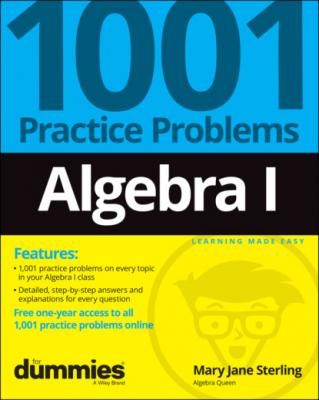Algebra I: 1001 Practice Problems For Dummies (+ Free Online Practice). Mary Jane Sterling
Читать онлайн.| Название | Algebra I: 1001 Practice Problems For Dummies (+ Free Online Practice) |
|---|---|
| Автор произведения | Mary Jane Sterling |
| Жанр | Математика |
| Серия | |
| Издательство | Математика |
| Год выпуска | 0 |
| isbn | 9781119883494 |
52.
53.
54.
55.
56.
57.
58.
Introducing Some Non-Traditional Grouping Symbols
59–64 Simplify the expressions involving radicals and absolute value.
59.
60.
61.
62.
63.
64.
Distributing Multiplication over Addition and Subtraction
65–72 Perform the distributions over addition and subtraction.
65.
66.
67.
68.
69.
70.
71.
72.
Associating Terms Differently with the Associative Property
73–78 Use the associative property to simplify the expressions.
73.
74.
75.
76.
77.
78.
Rearranging with the Commutative Property
79–84 Use the commutative property to simplify the expressions.
79.
80.
81.
82.
83.
84.
Applying More Than One Property to an Expression
85–90 Simplify each expression using the commutative, associative, and distributive properties.
85.
86.
87.
88.
89.
90.
Chapter 3
Working with Fractions and Decimals
Fractions and decimals are closely related. A fraction can be expressed as either a repeating or terminating decimal. A decimal is a special type of fraction — it always has a denominator that’s some power of ten. Decimal numbers are often written with a lead zero. You’ll see 0.031 instead of .031. The lead zero helps keep the decimal point from getting overlooked.
The Problems You’ll Work On
In this chapter, you’ll work with fractions and decimals in the following ways:
Adding and subtracting fractions by finding a common denominator
Multiplying and dividing fractions by changing to improper fractions and reducing where possible
Simplifying complex fractions
Adding and subtracting decimals by aligning decimal points
Multiplying decimals by assigning the decimal place last
Dividing decimals by assigning the decimal place first
Changing fractions to decimals — repeating or terminating
Changing decimals to fractions and then reducing
